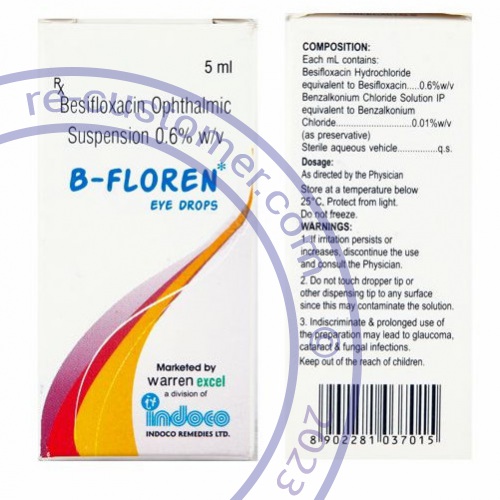- Trusted Tablets
- Antibiotics, Eye Care
- Besivance

Brand(s): B-Floren
Manufacturer: Indoco Remedies Ltd.
Disease(s): Bacterial Eye Infections
| Package | Price | Per dropper | Savings | Order |
|---|---|---|---|---|
| 0.6% 5ml × 5 droppers | $ 159.95 | $ 31.99 | $ 164.80 | Add to cart |
| Free AirMail shipping | ||||
| 0.6% 5ml × 4 droppers | $ 134.95 | $ 33.74 | $ 124.85 | Add to cart |
| 0.6% 5ml × 3 droppers | $ 114.95 | $ 38.32 | $ 79.90 | Add to cart |
| 0.6% 5ml × 2 droppers | $ 89.95 | $ 44.98 | $ 39.95 | Add to cart |
| 0.6% 5ml × 1 dropper | $ 64.95 | $ 64.95 | Add to cart | |
Besivance ophthalmic
What is Besivance?
Besivance (besifloxacin) belongs to a group of antibiotics called fluoroquinolones. Besifloxacin fights bacteria in the body.
Besivance is an antibiotic medication that is used to treat bacterial infections of the eyes.
Besivance may also be used for purposes not listed in this medication guide.
Important Information
You should not use Besivance if you are allergic to besifloxacin.
Use this medication exactly as prescribed by your doctor. Do not use it in larger amounts or for longer than recommended. Follow the directions on your prescription label.
Serious side effects of Besivance may include eye drainage or crusting, severe eye irritation, feeling like there is something in your eye, eye redness or swelling, fever, or any signs of new infection.
Keep using Besivance for the full prescribed length of time. Your symptoms may improve before the infection is completely cleared.
Do not use this medication while you are wearing contact lenses. This medication may contain a preservative that can be absorbed by soft contact lenses. Wait at least 15 minutes after using Besivance before putting your contact lenses in.
You should not wear contact lenses while you still have active symptoms of the eye infection you are treating.
Before taking this medicine
You should not use Besivance if you are allergic to besifloxacin.
Before using this medication, tell your doctor if you are pregnant or plan to become pregnant during treatment. It is not known whether besifloxacin passes into breast milk or if it could harm a nursing baby. Do not use Besivance without telling your doctor if you are breast-feeding a baby.
How should I use Besivance?
Use Besivance eye drops exactly as prescribed by your doctor. Follow all directions on your prescription label and read all medication guides or instruction sheets.
Do not use while wearing soft contact lenses. A preservative in this medicine could permanently stain the lenses. Use the medicine at least 15 minutes before inserting your contact lenses.
Wash your hands before using eye medication.
To apply Besivance eye drops:
- Turn the bottle upside down and shake it once before each use.
- Tilt your head back slightly and pull down your lower eyelid to create a small pocket. Hold the dropper above the eye with the dropper tip down. Look up and away from the dropper as you squeeze out a drop, then close your eye.
- Gently press your finger to the inside corner of the eye (near your nose) for about 1 minute to keep the liquid from draining into your tear duct.
- Do not allow the dropper tip to touch any surface, including the eyes or hands. If the dropper becomes contaminated it could cause an infection in your eye, which can lead to vision loss or serious damage to the eye.
Use this medicine for the full prescribed length of time. Your symptoms may improve before the infection is completely cleared. Skipping doses can increase your risk of infection that is resistant to medication.
Store this medicine in an upright position at room temperature away from moisture and heat. Keep the bottle tightly closed when not in use..
Besivance dosing information
Usual Adult Dose for Bacterial Conjunctivitis:
Instill 1 drop in the affected eye(s) 3 times a day, 4 to 12 hours apart, for 7 days.
Use: For the treatment of bacterial conjunctivitis due to susceptible isolates of Aerococcus viridans, CDC coryneform group G, Corynebacterium pseudodiphtheriticum, C striatum, Haemophilus influenzae, Moraxella lacunata, M catarrhalis, Pseudomonas aeruginosa, Staphylococcus aureus, S epidermidis, S hominis, S lugdunensis, S warneri, Streptococcus mitis group, S oralis, S pneumoniae, S salivarius
Usual Pediatric Dose for Bacterial Conjunctivitis:
1 year or older: Instill 1 drop in the affected eye(s) 3 times a day, 4 to 12 hours apart, for 7 days.
Use: For the treatment of bacterial conjunctivitis due to susceptible isolates of A viridans, CDC coryneform group G, C pseudodiphtheriticum, C striatum, H influenzae, M lacunata, M catarrhalis, P aeruginosa, S aureus, S epidermidis, S hominis, S lugdunensis, S warneri, S mitis group, S oralis, S pneumoniae, S salivarius.
What happens if I miss a dose?
Use the medicine as soon as you can, but skip the missed dose if it is almost time for your next dose. Do not use two doses at one time.
What happens if I overdose?
An overdose of Besivance is not expected to be dangerous. Seek emergency medical attention or call the Poison Help line at 1-800-222-1222 if anyone has accidentally swallowed the medication.
What should I avoid while using Besivance?
Do not use Besivance eye drops while you are wearing contact lenses. Besivance may contain a preservative that can be absorbed by soft contact lenses. Wait at least 15 minutes after using the medication before putting your contact lenses in.
You should not wear contact lenses while you still have active symptoms of the eye infection you are treating.
Besivance side effects
Get emergency medical help if you have signs of an allergic reaction to Besivance: hives; difficult breathing; swelling of your face, lips, tongue, or throat.
Call your doctor at once if you have:
- drainage or crusting of your eye;
- severe eye irritation after using the eye drops;
- feeling like there is something in your eye;
- severe eye redness or swelling; or
- fever, or any signs of a new infection.
Common Besivance side effects may include:
- eye redness.
What other drugs will affect Besivance?
Medicine used in the eyes is not likely to be affected by other drugs you use. But many drugs can interact with each other. Tell each of your healthcare providers about all medicines you use, including prescription and over-the-counter medicines, vitamins, and herbal products.
Further information
Remember, keep this and all other medicines out of the reach of children, never share your medicines with others, and use Besivance only for the indication prescribed.
Always consult your healthcare provider to ensure the information displayed on this page applies to your personal circumstances.

Can i help you?



